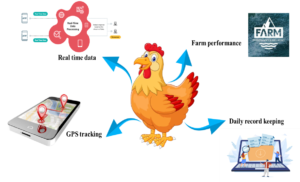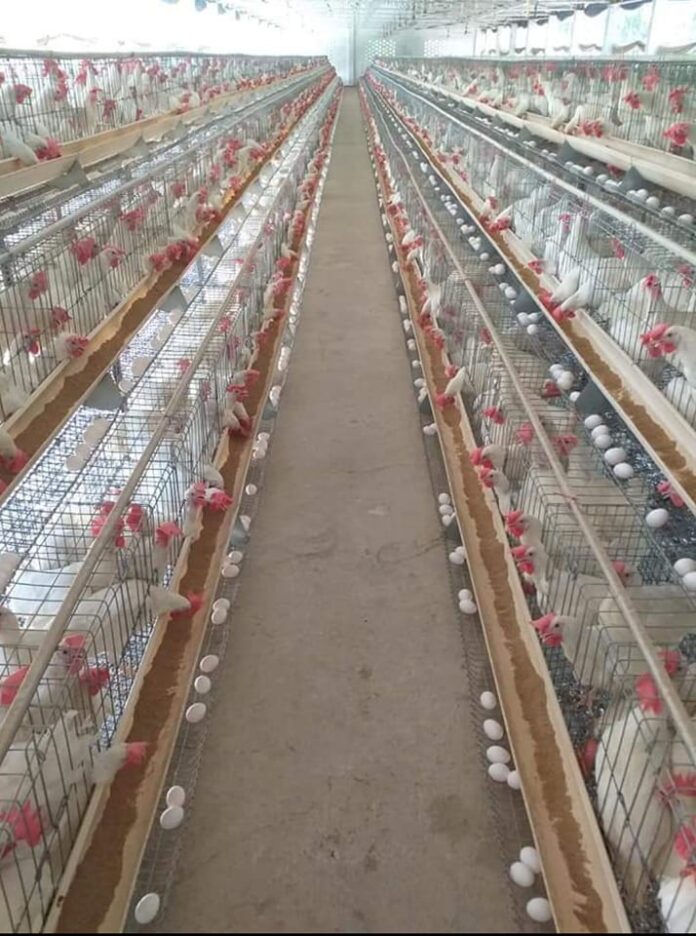Innovative Technology & Practices transforming India’s Poultry Farming Sector
Nutan Chauhan1 and Sravani Balaga2
PhD1 scholar, Animal nutrition Division
PhD2 scholar, Animal nutrition Division
National dairy research institute, Karnal, Haryana
Email id- nutanc03@gmail.com
Introduction:
Poultry refers to domesticated birds raised for a variety of reasons, most notably meat and eggs. Chickens, turkeys, ducks, geese, and quails are examples of common poultry. To meet the demand for chicken products, these birds are particularly developed and controlled inside the poultry business. Poultry farming is a key component of the agricultural industry, supplying consumers worldwide with a consistent supply of protein-rich meat and eggs. The size and production methods of poultry farms might differ. Large-scale commercial poultry farms often adopt intensive production systems, where birds are reared in tight areas to enhance efficiency and output. Smaller-scale and free-range enterprises, on the other hand, priorities animal care and sustainability. Poultry products are widely available in supermarkets, grocery shops, and restaurants, meeting consumer demand for low-cost, high-quality protein sources. The poultry business is critical to satisfying global food demands and greatly contributes to the economies of many countries. Poultry consumption in India has increased as a result of factors such as fast population expansion, changing consumer dietary tastes, urbanization, and rising disposable incomes. India is one of the world’s leading producers of poultry meat and eggs, and the majority of poultry products consumed in the country are chicken meat and eggs. Chicken meat is the most popular among the general public due to its low cost, versatility in a variety of cuisines, and ubiquitous availability. Eggs are another essential food that is consumed both directly and as an ingredient in a variety of food preparations. Aside from that, rising consumer knowledge of the health benefits of poultry is driving up demand. Furthermore, favorable government efforts, such as the National Livestock Mission and subsidies and loans for poultry production, have played an important role in expanding the sector. Furthermore, technological developments and superior breeding practices have increased productivity and efficiency in the poultry business. Other factors driving market expansion in India include a wide consumer base, increased demand for protein-rich foods, and rising government backing. For decades, poultry farming has been an important component of India’s agricultural landscape, providing a steady source of revenue and nutrition to millions of people. However, due to novel technologies and practices, the sector has seen tremendous transition in recent years. This essay investigates the dynamic changes in India’s chicken farming sector, concentrating on the impact of cutting-edge technologies, sustainable practises, and the economic and social outcomes that emerge. It contains up-to-date information and references to demonstrate the sector’s growth and potential, offering light on the future of poultry farming in India.
Historical Overview of Poultry Farming in India
Poultry farming has been around for generations, with local chicken varieties raised for meat and eggs. However, until the mid-twentieth century, it remained primarily unorganized and small-scale. In the 1960s, the Green Revolution brought enormous changes to Indian agriculture, particularly chicken rearing. Improved breeds, better nutrition, and the establishment of commercial hatcheries all made an impact. Dr. B. V. Rao founded the first commercial poultry farm in India, Venkateshwara Hatcheries, in 1971. This marked the beginning of the country’s organized chicken farming. The industry grew throughout time, with new players joining the market. Broiler chicken production and egg production became the key emphasis areas, and the business started to embrace modern practices. India had become one of the world’s leading producers of eggs and grill meat by the 1990s. India currently ranks third in the world for egg production and fifth in the world for chicken meat output. Nonetheless, it wasn’t until the last two decades that innovative technology and sustainable practices began to transform the business.
India Poultry Market
The India poultry industry is expected to be worth roughly USD 28.18 billion in 2023. Between 2023 and 2032, the market is expected to develop at an 8.1% CAGR. The market is expected to increase at a healthy rate between 2024 and 2032, reaching around USD 44.97 billion by 2032. Rising disposable incomes, a growing food services market, an increasing population, increased consumption, rising health awareness, increased intake of protein-based foods, and the development of distribution networks are expected to aid market growth. The increased use of online meal delivery channels for food ordering is one of the important market trends driving the growth of the poultry market.

The poultry market can be divided into two segments: eggs and broilers. In terms of end uses, homes dominate the egg segment, while food services are the market’s major end-use sector for broilers. Traditional retail stores dominate the grill and egg segments of the industry in terms of distribution channels. The major poultry-producing states in India are Maharashtra, Tamil Nadu, Andhra Pradesh, Telangana, Haryana, West Bengal, Karnataka, Madhya Pradesh, Uttar Pradesh, Bihar, Punjab, Rajasthan, Orissa, and Kerala, with Andhra Pradesh and Maharashtra accounting for the largest market share. IB Group, Suguna Foods Private Limited, Skylark Hatcheries Pvt. Ltd, Venky’s (India) Limited, Srinivasa Farms, Bharati Poultry Pvt. Limited, RM Hatcheries, The KEGGFARMS, AMD integrated Farms, and Kadkanath Agro World are among the prominent competitors in the aforementioned market.
Industry and government role
Only 5% of the chicken is processed and marketed chilled or frozen. The remainder is sold as live chicken. In India, there is a need to actively promote chicken and egg intake. There is a need to increase the proportion of processed chicken. A government package can assist in the installation of modern processing facilities, ensuring that at least 50% of broilers are processed before they reach customers. Consumers have several misconceptions regarding eggs and poultry, such as the use of hormones, antibiotic residues, caged animals, and desi eggs. Consumers, doctors, dieticians, chefs, instructors, and others must be educated. Associations could volunteer for year-round active promotion through events such as cooking shows. Our exports are insignificant. Because schools were closed, mid-day lunches, which included eggs, were halted. The government should provide eggs to police officers, doctors, nurses, and other hospital, jail, and government office personnel. Poultry meat and eggs should be provided in company canteens. There is a need for the development of ready-to-eat and ready-to-cook foods. The poultry industry should learn from the dairy industry on product value addition and marketing. Placements should be planned in accordance with demand. There should be cooperation among poultry enterprises functioning in a specific area. New talent should be drawn to poultry farming. The veterinary college can play an essential role in coordination between the government and poultry farmers, as well as in poultry farmer training. Poultry growers should cultivate good relationships with veterinarians working in Animal Husbandry departments, as well as legislators, in order to raise concerns with the government. There is a need to revise the VCI syllabus so that students learn more about the poultry industry last year. Industry and colleges should collaborate with women’s self-help groups and farmer producer companies, as well as NGOs, to promote poultry farming. Vets can play an essential role in the growth of the poultry industry in both the short and long term. Traditional training methods as well as social media should be used to reach a broad number of farmers and customers. Every farmer now has a smartphone, and during the lockdown, he learned how to utilize social media platforms such as YouTube, Whatsapp, and Facebook, among others. Industry should assist non-governmental organizations (NGOs) that engage with farmers to enhance profitability and production. All parties who desire to work with farmers must have trust.
Rise in adoption of technology and automation
Adoption of technology and automation is a prominent trend in the Indian poultry business, revolutionizing poultry farms and operations. Poultry farms are employing advanced farm management systems that use technology to improve efficiency. These include automated feeding systems, climate control systems, and data monitoring software. In chicken farms, technology is being used to monitor and diagnose diseases. Sensors and cameras in systems can continually monitor bird behavior, feed intake, water use, and other vital signs to spot any odd patterns or symptoms, allowing for early intervention and preventing disease transmission. Furthermore, egg collection and processing have grown increasingly mechanized, lowering labor needs and increasing efficiency. Apart from this, the increasing

popularity of precision farming techniques is further supporting market growth.
Innovative Technology in Poultry Farming:
Automation and Robotics:
Automation and robots are becoming an essential part of contemporary chicken farming operations. Robot-assisted egg collecting, automated feeding and watering systems, and climate control have all decreased labor costs and increased efficiency. Robots using artificial intelligence and sensors can monitor poultry health and behavior, allowing for early illness detection and precise treatment. Automated egg collection and grading systems make gathering, sorting, and packing eggs easier. These techniques are being implemented by Indian egg producers in order to eliminate human handling while maintaining egg quality.
Genetics and Breeding:
Recent breakthroughs in breeding have been critical in transforming India’s chicken economy. The introduction of high-yielding breeds and the use of genetic selection techniques have considerably enhanced poultry farm output. For example, the introduction of commercial layers and broilers, which develop quicker and produce more eggs and meat, has changed the game. Indian agricultural universities and institutions have done genomic selection research in chicken, which employs genetic markers and DNA sequencing to forecast the breeding value of individuals, hence quickening genetic advancement.
Precision Nutrition:
Advances in nutrition research have enabled more precise feed formulation, resulting in higher growth rates and feed conversion ratios. Precision nutrition ensures that birds get the proper nutrients at the right time, improving their health and production while decreasing waste. To increase meat yield, feed a diet with a reasonable energy content. Maintain a balanced amino acid profile while paying attention to meat quality. Vitamin and mineral levels should be adjusted based on growth rate and body weight. Use feed additives to promote nutrient utilization and animal health.
Artificial Intelligence:
Data analytics and artificial intelligence are being used to handle massive volumes of data generated on chicken farms. Farmers may use predictive analytics to make better judgements about disease control, feed optimization, and production planning. Artificial intelligence-powered computers analyze environmental parameters to provide optimal circumstances for poultry growth. Automation and the Internet of Things (IoT) have transformed the chicken farming industry. Smart sensors and monitoring systems are utilized in chicken houses to control temperature, humidity, and lighting. Automated feeding and watering systems offer proper nutrition for birds while reducing labour costs. According to Markets & Markets, the global smart poultry farming market is expected to grow at a 11.4% CAGR from 2021 to 2026.
Economic and Social Impact:
Adoption of new technologies and sustainable chicken farming practices has had significant economic and social consequences in India. The contribution of the poultry sector to India’s GDP has continuously increased, owing to increased output and value addition. The sector has produced job possibilities, particularly in rural areas, and has provided income for millions of small-scale farmers. The poultry business has grown to be a substantial contributor to the Indian economy, creating jobs and supporting ancillary sectors such as feed manufacture and processing. According to the Ministry of Fisheries, Animal Husbandry, and Dairy, the poultry sector contributed 1.48% of the country’s agricultural GVA in 2020-21. (2020-21 Economic Survey). Farmers’ lives have improved as a result of the implementation of modern poultry farming practices. Higher yields, lower mortality rates, and cheaper production costs have raised farmers’ earnings and transformed chicken farming into a sustainable and successful business. chicken farming, particularly backyard and small-scale chicken husbandry, provides rural families with a consistent source of income. A family with a few layers or broilers, for example, can sell eggs or meat in local markets, earning money for home needs, schooling, and healthcare. Commercial poultry farming enterprises, such as broiler and layer farms, create jobs in both urban and rural locations. Feeding, cleaning, and upkeep are all activities that require workers. Furthermore, the entire chicken supply chain—including feed manufacturing, delivery, and marketing—generates work for a large number of individuals. Women frequently have prospects for economic development and revenue generation in the poultry industry. Women can raise chickens in their backyards while still managing their domestic obligations. Farmers can diversify their income streams with poultry farming, which lessens reliance on a particular crop or agricultural endeavour. The danger of crop failure and price swings is reduced thanks to this diversity. Eggs and chicken meat are two examples of poultry items that are excellent suppliers of protein and other vital elements. By allowing families access to these healthy items, small-scale chicken farming can enhance family nutrition.
Export Potential:
India’s poultry exports reached a record high of 10 million metric tonnes in 2022 (Directorate General of Foreign Trade, 2023), indicating that Indian chicken goods are becoming more popular on international markets. In order to access global markets, Indian poultry exports need a well-organized export strategy. Here are some essential tactics and instances of Indian poultry enterprises using them effectively. After doing market research and finding potential markets, Venky’s India Ltd. increased the export of poultry products to a number of nations, including the Middle East, Southeast Asia, and Africa. Suguna Foods made investments in cutting-edge processing facilities and strict quality control procedures to ensure that its goods met international standards and could be exported to more than 60 nations. For its products, Venky’s India Ltd. gained Halal certification in order to serve markets with sizable Muslim populations.
Market Entry Strategies:
To increase its footprint in the international chicken industry, Srinivasa Farms established cooperative ventures with foreign businesses. Venky’s India Ltd. participates in international trade events and exhibits to promote its poultry products abroad. Suguna Foods has earned the trust of customers worldwide by utilizing cutting-edge technologies for quality control and product traceability. Suguna Foods provides goods in a variety of export markets that are adapted to local tastes, such as chicken curry chops made for Indian cuisine.
Future outlook for poultry sector in India
A population of five crores is directly or indirectly reliant on the poultry industry. In 2019, over 5 million MT of poultry meat (85,000 crores) were produced, although the average annual consumption remains at 3.4 kg. 109 billion eggs were produced at the same time period (45000 crores worth), yet only 80 eggs are available per person. It must first receive backing from the federal and state governments. The greatest method to advertise poultry goods is with a startup culture. Due to rising urbanization, a growing middle class, and higher per capita spending on animal protein, the consumption of poultry and eggs will rise more quickly in the upcoming ten years. The research conducted by the ICAR and veterinary colleges does not align with that of the industry. Modern technology is required in every aspect of raising and selling chicken.
Conclusion
The chicken farming industry in India has gone a long way from its traditional roots to adopt cutting-edge technology and environmentally friendly practices. Increased productivity, economic growth, better farmer livelihoods, and improved nutritional security have all resulted from this transition. Recent data and references show how significantly the sector affects India’s agriculture and economy. As the globe continues to face difficulties with food security, India’s poultry farming industry serves as a shining example of how innovation may lead to beneficial change in agriculture. There has to be a substantial focus on poultry science education and training, research, and extended cooperation between poultry scientists and veterinarians. Technology adoption is still hampered by a lack of cooperation between the public and commercial sectors as well as by a lack of creative ways for businesses and consumers to express their concerns to policymakers.
Innovative Technologies and Practices Transforming India’s Poultry Sector


